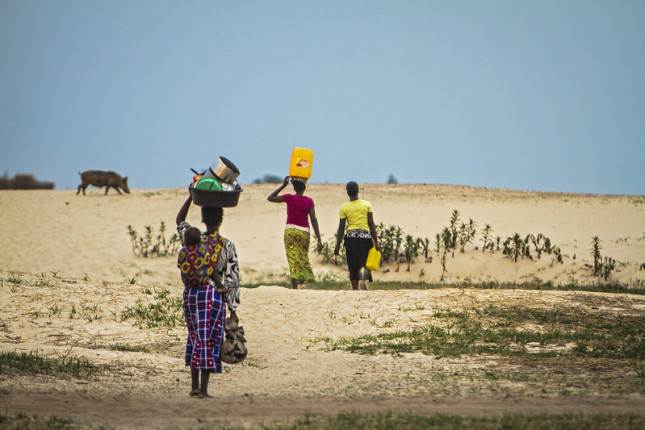-
High Temperatures Threaten Maternal and Newborn Health–Climate Change Policy Must Adjust
September 6, 2023 By Sophia DeLuca
Extreme heat can be deadly, and 2023 is on track to be the hottest year on record. In the United States, heatwaves cause more deaths than any other weather related events. In Europe, close to 62,000 deaths during Summer 2022 were linked to heat related causes. Globally, an estimated 5 million people a year die from extreme temperatures–hot and cold.
During pregnancy, the body is less efficient at regulating body temperature, making pregnant people especially vulnerable to heat-related illnesses. A 2023 research review by the Atlantic Council, published in the Journal of Midwifery and Women’s Health, found that exposure to extreme heat has substantial impacts on maternal and newborn health (MNH), most notably, on preterm birth and stillbirth risk.
Preterm birth occurs when a baby is born prior to 37 weeks of gestation. Every year, 1 million premature babies die–making preterm birth the number one cause of neonatal mortality, and a determinant of future health challenges and disability. Risk of preterm birth increases 12-16% when temperatures rise 5°F in the week leading up to birth, and heatwave conditions increase risk of preterm birth by 1.16 times.
Stillbirth risk is also significantly impacted by heat exposure. A stillbirth is classified as a baby born with no sign of life who dies at or after 28 weeks of pregnancy. In 2021, there were 1.9 million stillbirths, globally. As heatwaves increase in frequency and severity, progress in reducing stillbirths may be impacted by rising temperatures. Several studies included in the Atlantic Council review indicate that increase in maternal heat exposure leads to heightened risk of stillbirth.
In addition to stillbirth and preterm birth, maternal exposure to extreme heat can impact maternal mental health, gestational diabetes, gestational hypertension, cardiovascular events, and placental abruption.
While pregnant people everywhere are affected by heat and temperature changes, disparities in access to cooling resources and healthcare, cultural practices, and socio economic status, create a disproportionate burden on certain communities and individuals. The 2023 Human Rights Watch (HRW) article: “It’s Time to Combine the Fights for Climate Change and Reproductive Justice,” largely based on HRW’s 2020 report on extreme temperature and pregnancy, explores heat, along with other climate change fueled crises, as a reproductive justice issues.
In the United States, research indicates that health outcomes for Black pregnant women during extreme heat, including preterm birth and maternal complications, are worse than other racial groups. This disparity is likely fueled in part by unequal access to air-conditioning and the impacts of urban “heat islands,” or microclimates substantially hotter than surrounding areas due to infrastructure differences, typically concentrated in lower-socio economic neighborhoods. One study found that on average, historically redlined neighborhoods are more than 2.6°C warmer than non-redlined areas. Redlining, a practice that occurred from 1930s–1968, refers to the creation of maps that guided government-issued mortgages–neighborhoods where Black people lived were outlined in red and considered risky investments and poor choices for loan eligibility.
The HRW calls for a joint action on climate crises and reproductive health: “Research affirms what we already know to be true, that all communities’ right to a healthy environment should be in the bucket together with access to safe abortion, birth control, family planning, and maternal health care.”
In order to achieve this, climate change and heat policies at subnational, national, and international stages must acknowledge pregnant people as a vulnerable group impacted by extreme heat and climate change, and provide specific steps to protect these individuals and their babies. In 2020, HRW conducted a review of 100+ policy, action, and advisory pages on heat and climate change from 18 US cities. Just two of the documents reviewed included information about the health threats of heat for pregnant people. HRW’s 2020 review of German climate adaptation plans found similar results: documents “largely fail to include the needs of those who are pregnant during extreme heat.” While country plans may have altered since 2020 and the increased recognition of the impacts of climate, the siloing of climate action from maternal health takes place globally, evidenced by just six of the 50 countries with nationally determined contributions to the Paris Agreement, the international treaty on climate change, mentioning sexual or reproductive health at all, per a 2021 report.
In addition to inclusion of pregnant people in heat policy and action plans, drivers of heat-related health disparities should be addressed, including access to air-conditioning and energy assistance programs, urban infrastructure that cools cities, and workplace protections for pregnant people. It is clear that extreme heat will continue to have significant impacts on MNH as temperatures keep climbing. In order to address these effects, an intersectional approach to extreme heat and other climate change fueled crises must include maternal health, and all other reproductive health justice issues.
Sources: The New York Times, CNN, The Guardian, Journal of Midwifery & Women’s Health, World Health Organization, New Security Beat, White Ribbon Alliance, Climate, Human Rights Watch, UNFPA.
Photo Credit: Fetching water during dry season, Mongu, Western Zambia. Photo by Felix Clay/Duckrabbit, 2012.
 A Publication of the Stimson Center.
A Publication of the Stimson Center.



